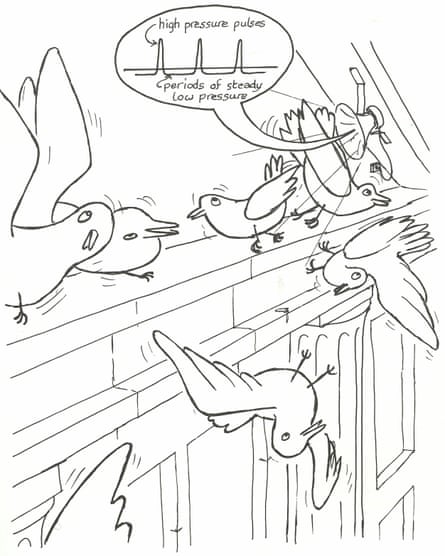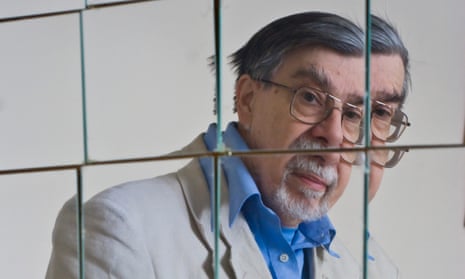David Jones, who has died aged 79, was a physical chemist and writer who, through his columns under the pseudonym Daedalus, entertained readers of New Scientist, Nature and the Guardian for more than 30 years. His ideas for inventions started from secure principles and wove a plausible tale through to the impossible – or so he thought. In fact, many turned out to be feasible. His version of 3D printing with lasers even landed him in a patent dispute in 1974.
He described how to coat the moon in a reflective layer so that northerners would be released from their dark winters and “lovers would blink in its unromantic glare”. His remote-controlled painting machine would climb walls with the aid of slug slime and allow mountain bikes to go up vertical cliffs. He foresaw the problems of the information age and proposed a system of computerised billing that paid a fee every time personal information was passed on.
Daedalus and his fictional company, Dreadco (Daedalus Research Evaluation and Development Corp), set out, like many scientists, to trace the consequences of a “what if” idea. The difference for Daedalus was that he built in an intentional flaw. While professional scientists find all too often that their ideas fail, Daedalus anticipated failure but instead sometimes found that his ideas succeeded. In 1966, he proposed to make hollow molecular balls by persuading sheets of graphite to close up (graphite is composed of sheets of carbon atoms arranged like chicken wire). In 1985, Harry Kroto, Robert Curl and Rick Smalley described just such a molecule, carbon-60 (now known as a buckminsterfullerene), for which they received the Nobel prize in 1996. A mutual friend pointed out the Daedalus column to Kroto, who acknowledged it in his Nobel lecture.
David anticipated the development of the chemical laser by a year and pitched it as a weapon for shooting down ballistic missiles. Fifteen years later, Ronald Reagan proposed this same idea in his star wars programme.
In 1980 David speculated in a BBC Radio Scotland programme that Napoleon might not have been poisoned by arsenic deliberately as suggested by analysis of his hair, but as a result of the wallpaper in his rooms on St Helena. In a damp environment, the mould on a particular green pigment, fashionable at that time, catalyses the generation of a toxic gas containing arsenic. Tongue in cheek, David asked if any listener knew the colour of Napoleon’s wallpaper. To his amazement a woman wrote in that a scrapbook had been handed down to her containing an actual sample. David’s research on that piece of wallpaper, published in Nature (1982), showed that the pigment was indeed present.
David started writing his Daedalus columns for New Scientist in 1964 and continued there for 24 years before transferring to Nature and the Guardian. The columns were compiled in The Inventions of Daedalus (1982) and The Further Inventions of Daedalus (1999), both illustrated by his own cartoons.

Television was another outlet for his ingenuity. In the mid-70s, David was the man behind the scenes for Yorkshire Television’s Don’t Ask Me with Magnus Pyke and The Scientific Eye with Adam Hart-Davis. Finding that the questions from the studio audience did not lend themselves to demonstrations, he built the demonstrations first and then planted questions in the audience. Eventually, frustrated by health and safety restrictions, he left YTV and began presenting on the German TV science quiz show Kopf um Kopf (Head to Head), where he stayed for eight years. In 1987 he was the subject of a BBC QED programme, which realised one of his inventions: a bus on which each passenger was given a steering wheel, and which then proceeded in a “majority” direction.
David’s book The Aha! Moment (2012) muses on the creativity of science, describing the unconscious mind as “the random ideas generator”, with some of his demonstrations as examples: a birthday cake with 100 candles that light simultaneously; a Frisbee that levitates on a column of air; a geyser that blows once a minute. David made these gadgets out of simple components: the geyser used an electric kettle, copper pipe, a bicycle inner tube and some glass tubing. His house in Newcastle was filled with the detritus of these experiments – a veritable Aladdin’s cave.
The secret of one invention was never revealed, even to his closest friends – the fake perpetual motion machine. The idea of perpetual motion violates the laws of physics, as was proved in the 19th century, yet David fooled many into thinking it was possible through his machines, all incorporating a spinning bicycle wheel with no obvious power source. He exhibited them in science museums worldwide, and kept one at home, which was still spinning when I last visited a few months ago.
David was born in south London to Philip, a copywriter, and Dorothea (née Sitters), a secretary. During his childhood he built rockets, played with photography and drew animated cartoons. He attended Eltham college then studied chemistry at Imperial College, London, as an undergraduate, research student and postdoctoral researcher (1956-67). He started writing the Daedalus column for New Scientist during this time, through a student friend who had begun working at the magazine.
Following a year teaching at Strathclyde University, he went to work for ICI in Runcorn as a spectroscopist. I met him soon afterwards and he told me about his trials of unrideable bicycles in the ICI car park, part of his investigations into bicycle stability. The most popular theory claimed that the forces generated by a revolving wheel stabilised the bike (the gyroscope theory). His experiments killed off that idea, but he found he could make a bike unrideable by changing the geometry of the steering. These studies led to his most influential genuine scientific publication (Physics Today, 1970).
In 1973, he moved with a research fellowship to the chemistry department at Newcastle University, where I was then a research student. He remained a guest member of the department and lived in the city for the rest of his life. He received the Shaw medal from Nottingham University in 1996 and an honorary doctorate from Newcastle University the following year.
His columns continued until 2000, when David suffered a stroke. After his recovery he continued writing, but retired Daedalus. David’s final book, Why Are We Conscious?, inspired by his experience of the stroke, was published earlier this year. A documentary film about David, Perpetual Motion Machine (2009), explores not only his genius, but also his recovery.
David loved to entertain, but privately he was a loner with a sceptical view of humanity, as is apparent in his last column: “The big problem is the readiness with which human beings tell lies. Indeed, this is almost the defining mark of humanity.”
David’s marriage to Janet Burgess in 1972 ended in divorce. He is survived by his younger brother, Peter, his nieces, Philippa and Phoebe, and his nephew, Tom.

Comments (…)
Sign in or create your Guardian account to join the discussion